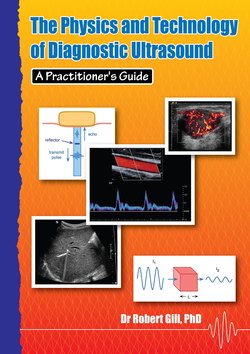Читать книгу The Physics and Technology of Diagnostic Ultrasound: A Practitioner's Guide - Robert Gill - Страница 22
На сайте Литреса книга снята с продажи.
Reflection and scattering Reflection
ОглавлениеReflection and scattering are the two mechanisms that produce echoes and so create the information shown in the ultrasound display.
As with light, the word "reflection" is used to describe the interaction of ultrasound with relatively large and smooth surfaces. (Think of light reflecting from glass.) "Scattering" refers to the interaction of ultrasound with small structures (red blood cells, capillaries, etc) within the tissues. (Think of light scattering from the tiny water droplets in a fog.)
Before we can discuss reflection, we must first introduce the concept of the acoustic impedance (sometimes called the characteristic impedance) of a tissue. It is defined as:
where z is the acoustic impedance, ρ is the density of the tissue (i.e. the weight per unit volume) and c is the ultrasound propagation speed. The units for acoustic impedance are called Rayls.
Acoustic impedance is a useful concept because it is a measure of how the tissue "appears" to the ultrasound. Two tissues with similar acoustic impedance values will appear similar to the ultrasound, while tissues with very different impedances will look very different. If two tissues happened to have the same value of acoustic impedance they would look identical to the ultrasound.
It is important to realise that tissues may look very similar on ultrasound and yet be totally different histologically. As an example, pus can look very similar in an ultrasound image to soft tissue.
How is this related to reflection?
Consider the three situations shown in Figure 2.7 (a), (b) and (c). It is clear that the amount of energy reflected is determined by the degree to which the acoustic impedances in the two tissues are different.
Figure 2.7 (a) Total reflection of the ultrasound energy at an interface between two tissues with a very large acoustic impedance difference (e.g. a soft-tissue - air interface). All of the energy is reflected and none is transmitted into the second tissue. The interface will be seen in the image as a strong linear structure.
Figure 2.7 (b) Total transmission of the ultrasound energy when the two tissues have identical acoustic impedance (i.e. z1 = z2). No energy is reflected and so there will be no echo – the interface will not be seen in the ultrasound image.
Figure 2.7 (c) Partial reflection of the energy when the two tissues have somewhat different impedances (e.g. a liver tissue - fat interface). A fraction of the energy is reflected and the remainder transmitted. The interface will be seen in the image but it will not be as strong as in the total reflection case.
Mathematically the fraction reflected is given by the following equation, where z1 and z2 are the acoustic impedances in the first and second tissue respectively:
R is called the "reflection coefficient" of the interface (or sometimes the "intensity reflection coefficient"). Since the quantities in brackets are squared, it is easy to show that the reflection coefficient for a given interface will be the same no matter which way the ultrasound is passing through it (i.e. regardless of whether the ultrasound is going from tissue 1 into tissue 2 or vice versa).
Thus, for example, if R = 0.01 this means that 1% of the transmitted energy reaching the interface will be reflected and so 99% will be transmitted into the second tissue. It also means that any echoes returning from within the second tissue will lose 1% of their energy due to reflection as they pass through the interface on their way back to the transducer due to reflection from the interface.
It can also be shown mathematically that R is virtually 1.0 when z1 and z2 are very different (as in Figure 2.7 (a)) and R = 0 when z1 = z2 (as in Figure 2.7 (b)). This will be explored in the exercises at the end of this section.
Since energy cannot be created or destroyed, the sum of the reflected and transmitted energies must always be equal to the incident energy. Taking advantage of this fact, it can be shown mathematically that the "transmission coefficient" T must be given by:
(If you enjoy mathematics, you can check that this is correct.)
So far the discussion of reflection has focussed on the special situation where the ultrasound is incident on the interface at right angles (i.e. at an angle of 90° to the interface); this is termed "perpendicular incidence". What about the more general situation?
When the incidence is not perpendicular, the reflected ultrasound does not travel back to the transducer (see Figure 2.8). As a result the echo from the interface will not be detected and so it will not be seen in the image. (The equations for the reflection and transmission coefficients will also become more complex, but this is beyond the scope of this book.)
Figure 2.8 Geometry for the reflection of ultrasound from a smooth interface. The broken line is a reference line drawn at right angles to the interface. The "incident angle" θi is always equal to the "reflected angle" θr. This is the same geometry as for light reflecting from a mirror and hence it is called "specular" (mirror-like) reflection.
